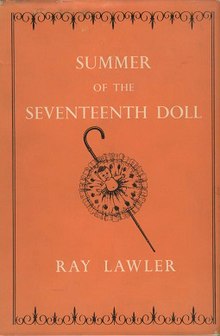|
Summer of the Seventeenth Doll
 Summer of the Seventeenth Doll is an Australian play written by Ray Lawler and first performed at the Union Theatre in Melbourne on 28 November 1955. The play is considered to be the most significant in Australian theatre history, and a "turning point",[1] openly and authentically portraying distinctly Australian life and characters. It was one of the first truly naturalistic "Australian" theatre productions. It was originally published by Angus & Robertson, before moving to Fontana Press and then Currency Press. PlotThe play is set in Australia, in the Melbourne suburb of Carlton, in the summer of 1953. Barnie and Roo have just returned from Queensland, where they have been working as sugar cane cutters. This is the period of “the layover”, five months of sex and fun which they traditionally share with two city women, named Olive and Nancy. This has been the pattern of the past seventeen years. As always, Roo has brought Olive a kewpie doll as a present – hence the title of the play. This is the summer of the seventeenth doll. But things have changed. Nancy has married, so Olive has invited Pearl Cunningham – a rather hoity-toity woman – to take over as Barnie’s date. And she makes the working-class Barnie feel that he is not good enough for her. Also on the scene are Kathie "Bubba" Ryan, a 22-year-old girl who has been coveting Olive and Nancy's risqué lifestyle from her neighbouring house almost all her life, and Emma Leech, Olive's cynical, irritable, but wise mother. As the play progresses, it becomes obvious that this summer is full of tensions. Roo and Barnie are feeling old. The new-comer Pearl is much less fun than her predecessor. And it turns out that Roo has had a bad season up north: he is broke and is forced to take a humiliating job in a paint factory. Meanwhile his mateship with Barney is under strain following a dispute between them back in the cane-fields. Roo is tired. He can’t face another season of cane-cutting and he asks Olive to marry him and settle down. But Olive is furious. She wants her old life, her old freedom, back. For her, marriage is the very opposite of life. In the final scene, the two men leave together, the summer prematurely ended. And we know that there will be no eighteenth doll. The party is over. Summer of the Seventeenth Doll is part of a trilogy generally referred to as the Doll Trilogy; the story of The Doll is preceded by the prequels Kid Stakes (1975), set in 1937, which tells the story of the first year of the tradition and the origin of the gift of the Kewpie doll, and Other Times (1976), which is set in 1945 and includes most of the same characters. ProductionsMelbourneThe Summer of the Seventeenth Doll had its world premiere on 28 November 1955, where it opened at the Union Theatre in Melbourne. This production of the play was directed by John Sumner and featured the following cast:
SydneyThe play opened in Sydney, approximately two months later, on 10 January 1956, this time with significant changes to its cast:[2]
Country tourOn 28 January 1956 a thirteen-week country tour of the play was announced, commencing on 14 February. The play toured New South Wales and Queensland, returning to Sydney for an encore season, and featured the following cast:
United KingdomAfter the final Sydney show of the play's country tour, The Doll moved to the United Kingdom, where it spent two weeks showing in Nottingham, Liverpool and Edinburgh before opening in London on 30 April 1957, with the following cast:[3]
New YorkEncouraged by its wholehearted reception in Australia and Britain, Summer of the Seventeenth Doll took a trip to America, where audiences and critics were rather underwhelmed with the production, most likely due to drastic cultural differences.[citation needed]. The play opened in New York City on 23 January 1958, with no changes made to the cast. The Doll only ran for a five-week season in America.[4] However, in 1967, Summer of the Seventeenth Doll featuring an all-black cast, was produced to great acclaim as one of four plays in the inaugural season of The Negro Ensemble Company with an international bill that included Kongi's Harvest by Wole Soyinka, Song of the Lusitanian Bogey by Peter Weiss, and Daddy Goodness by American playwright Richard Wright. Film adaptationAfter continuing to tour Australia through 1958, Summer of the Seventeenth Doll was adapted by Leslie Norman for Hecht-Hill-Lancaster Productions – whose first film had been Marty with Ernest Borgnine – for United Artists in 1959. The film was retitled Season of Passion for the American market.[5] This decision was severely lamented by some fans of the play, whose complaints were rooted in three essential criticisms:[citation needed]
1964 British TV adaptationThe play was adapted for British TV in 1964 as part of Thursday Theatre.[6] The cast was:
1979 Australian TV adaptationA version of the play was filmed in 1979, directed by Rod Kinnear.[7][8]|
Most recent productionsNotable productions include:[9]
The iPad appIn 2013 Currency Press released an iPad app which charted the 57-year history of Summer of the Seventeenth Doll.[15] The app collated archival material from the first production on 28 November 1955 up until the most recent Belvoir production, which toured the east coast of Australia in 2011/12. Material was sourced from a range of archives and institutions along the east coast of Australia. The app featured interviews with:
CritiquesReferences
External links
|